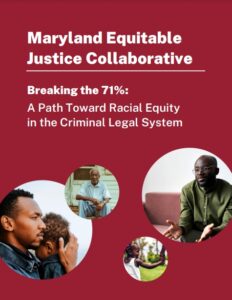The Maryland Alliance for Justice Reform (MAJR) is a nonpartisan, all-volunteer organization of more than 2000 Marylanders who advocate for evidence-based legislative and policy changes in Maryland’s correctional practices to support effective alternatives to incarceration, address inequities, and allow citizens returning from prison to lead productive lives.
We are working together to address the problem of mass incarceration in Maryland in several ways. We invite you to join us to accomplish our goals:
-
-
- Alternatives to incarceration
- Taxpayer savings
- Strong communities
- Ending inequities
-
- To fully support alternatives to incarceration where appropriate;
- To save taxpayer dollars and reallocate the savings to build safer communities;
- To strengthen Maryland communities by supporting families, helping people returning from jails and prisons lead productive lives, and preventing crime;
- To end inequities in our justice system.
The Maryland Equitable Justice Collaborative inaugural report, “Breaking the 71%: A Path Toward Racial Equity in the Criminal Legal System” (2025), examines the systemic factors contributing to the overrepresentation of Black Marylanders in the state’s correctional facilities and offers 18 concrete recommendations for reform.
Breaking the 71%: Full report
Breaking the 71%: Executive Summary

Contact:
Maryland’s Correctional Ombudsman, Yvonne Wilson-Briley:
Email can be sent to oco.contact@maryland.gov or
U.S. mail can be sent to 300 West Preston Street Room #213 Baltimore Maryland 21201.
Tell me more about…
| Our Justice System | Mass Incarceration |
| Solitary Confinement | Racial Inequality |
| Mental Health | Education |
| Recidivism | Pretrial Justice |
| Pandemic – COVID-19 | Police Action |
The Power of Prosecuters: An Overview
Maryland shouldn’t wait any longer for criminal justice policies that work!
- Maryland’s incarceration rates & taxpayer costs more than tripled in 20 years (1980-2000) — including a 55% increase for nonviolent offenders1 — but crime rates held constant2. Our incarceration rates and costs—over $45,870 per inmate per year3 — remain near record-high levels.
- African-Americans, only 25 per cent of Maryland’s population, disproportionately constitute 78 per cent of the inmate population4. Upon release, a prison record damages employment prospects. With programs to reduce the “collateral consequences” of imprisonment like those that have proven successful in other states, returning citizens could find jobs, support their families, and become taxpayers themselves, rather than being supported by taxpayers.
- Maryland’s recidivism rate – new offenses that return an offender to prison within 3 years—has hovered between 41 and 51%. Other states such as Virginia and Oregon use evidence-tested methods to reduce these rates to 28% and 23%5.
- Like other states Maryland can employ “Justice Reinvestment” and make evidence-based policy improvements to substantially reduce recidivism, reduce crime, and simultaneously reduce taxpayer costs. Maryland’s Justice Reinvestment Coordinating Council is engaged in a 2-year review of the justice system in which stakeholders are invited to participate.
Click here to view our flyer introducing MAJR and its initiatives.



















